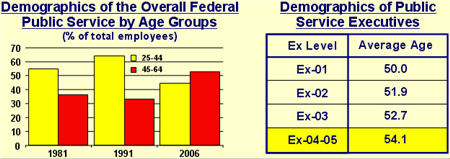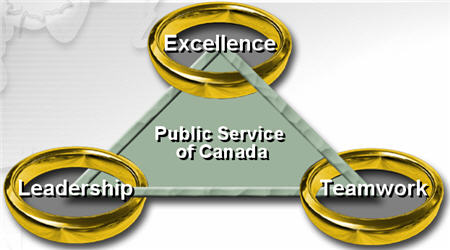|
Remarks by the Clerk of the Privy Council
And Secretary to the Cabinet
ADM Forum
Public Service Renewal: Some thoughts on renewal from the 14th
Annual Clerk’s Report, and the Advisory Committee on the Public Service
April 18, 2007
[ PDF Version
1,033 MB ] [ Powerpoint
Version 918 KB ]
“…We are in this process of renewal together, and for the long term. Collectively, it is
public servants themselves who are the true stewards of this vital institution, Canada’s Public Service…”
(14th Annual Report on the Public Service)
Why Renewal, and why now?
The answer, to put it simply, is this ---
- If the Public Service, as a core national institution, does not renew itself for future as well as current service to the government and people of Canada it risks becoming less relevant, less useful and less respected as the years go by.
- If we do not commit ourselves to a continuing process of renewal, the Public Service will not remain a creative national institution, central to the governance and development of our country.
(14th Annual Report on the Public Service)
What are the Drivers of Change?
…Global, societal…
Challenge of Public Service Renewal:
- Like the Canadian population, the Public Service is ageing, but at a faster rate.
- The Public Service is becoming more diverse, but needs to better reflect Canada’s diversity.
- The Public Service needs to better react to the changing nature of work driven by technology.
- The Public Service is facing the most competitive national labour market in over 30 years.
- The Public Service must adapt to changing public expectations towards more accountability, better management of tax dollars, and improved core public services.
- The “Public Service brand” is less clear and less positive in the public’s mind.
What are the Drivers of Change?
…Public Service demographics…

Other Core Demographics:
- Average age of new (indeterminate) Public Servants: 36 years
- Average age of new EX1’s: 46 years
- Public servants who can retire with non-reduced pensions: 7%
- ADMs who can retire with non-reduced pensions: 28.5%
What are the Drivers of Change?
…and the changing nature of our work
The Public Service has a wide and changing scope:
- Canada’s largest employer (250K employees)
- Canada’s most national employer (1600 points of service in Canada)
- Canada’s most multi-skilled workforce
- Canada’s most international employer (in over 150 countries)
- Plus, Canada’s military (65K soldiers); reserves(25K); and RCMP (20K)

What are the principles and processes supporting Renewal?
Principles Supporting Renewal:
- Renewal is not a top-down exercise: respect and involve employees at all levels
- Prioritize and focus: set goals and priorities that are relevant, ambitious and realistic
- Measurement matters: set benchmarks for performance and measure progress
- Excellence should be our hallmark: need to manage for it, to it
- Be flexible: learn through process of change, and be prepared to adjust course as we learn
Processes Supporting Renewal:
- DM’s Committee on Public Service Renewal
- Advisory Committee on the Public Service of Canada
- Mandate letters: all DMs now receive; multi-year in scope
- COSO: Clarity on role and approach to management of senior executives
- Clerk’s Report: annual, measurable, renewal objectives; accountability
Building a Public Service advantage for Canada…

…Focus on the essentials; and, prioritize short-term and medium-term actions
What is the Advisory Committee Telling Us?
1. We Matter
“The first premise for our work as a committee is that a well-functioning and values-based public service is critical to the success of every country in today’s complex and interconnected world. As a national institution, a high quality, merit-based Public Service is part of Canada’s comparative advantage and a key to competitiveness in the global economy. It also helps provide the foundation for sound democratic government”…
2. We Need to Change, to Renew
“We believe the overriding imperative for the Public Service today is to adapt to challenging new circumstances and to respond in innovative ways to the evolving needs of Canadians. Strong, values-based leadership, will be essential if Canada’s Public Service is to renew itself.”
Seven Observations:
- There is a clear requirement for a strong and sustainable Public Service that can be a source of pride and advantage.
- While today’s Public Service has obvious strengths, renewal is needed.
- Need a Public Service that is truly representative of Canadians of all backgrounds and from all parts of Canada.
- Need a strong positive Public Service “brand” to support marketing of our positions as attractive career options.
- Need leaders to model Public Service values; need to publicly recognize employee accomplishments.
- Need strategic planning that integrates HR management with business goals, and aligns talent with priorities.
- Need more systematic and rigorous programs of leadership development that equip leaders for success in the future.
Immediate focus: Recruitment
- Departments should take a more strategic and systematic approach to recruitment.
- No inherent virtue in programs of Public Service-wide recruitment (unless general functional community).
- The Public Service should establish a new 2007-2008 benchmark for post-secondary recruitment with a view to hiring most new graduates on an indeterminate basis, reducing reliance on terms and casuals.
- External recruitment of qualified individuals for senior leadership positions should be implemented on a priority basis.
Renewal Priorities for Short-term and Medium-term
1. Planning
Short-term action plan:
- Enhance integrated human resources and business planning; and
- Every department and agency have a human resources plan as an integrated part of its business planning.
Medium-term action plan:
- Develop new planning tools for simpler, more effective HR planning; and
- Develop a unified Public Service Human Resources Plan.
2. Recruitment
Short-term action plan:
- Focus on department-specific recruitment, involving the senior leaders of each organization;
- Address projected senior level shortages through both targeted development programs for current executives, and new external recruitment efforts for senior leadership positions; and
- Design pilot recruitment programs for specialized needs.
Medium-term action plan:
- Develop and articulate a “Public Service brand”;
- Coordinate the recruitment activities of departments and the Public Service Commission; and
- Review and renew our suite of leadership development programs.
3. Employee Development
Short-term action plan:
- Implement Canada Fellows Program;
- Ensure both individual learning plans and organisational learning plans; and,
- Implement ADM Talent Management Initiative.
Medium-term action plan:
- Development programs for functional communities;
- Performance management to explicitly include people management; and,
- Expand ADM Talent Management Initiative to other executive levels.
4. Enabling Infrastructure
Short-term action plan:
- Streamline human resources business processes and systems across government;
- Provide user-friendly data base of best practices to departments and agencies; and
- Develop public service-wide electronic platforms for on-line learning, networking and sharing best practices.
Medium-term action plan:
- Implement the streamlining of human resources business processes; invest in renewing the skills and leadership of the HR community; and
- Introduce new tools to support recruitment.
Renewal Objectives for the Longer-term

Public Service Renewal and Departmental Management Committees: Next Steps
- Focus now shifts to action plans, their implementation, not diagnostic
- Engagement of ADMs, Exs and employees
- Departmental, branch and managers’action plans
- Associate Secretary to the Cabinet meetings with Departmental management teams
|





